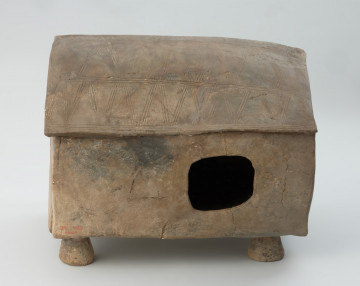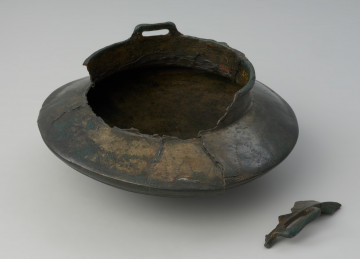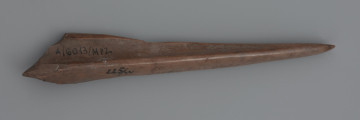
A cottage urn
around 750 p.n.e. — 550 p.n.e.
National Museum in Szczecin
Part of the collection: Bronze Age
It is an exquisitely preserved urn with an artistic representation of a human face. It is decorated with a small cap-shaped lid, bronze earrings in the "ears", and round engravings, probably imitating necklaces. The ashtray comes from a square cist grave made of stone slabs. The Museum in Szczecin bought it for its collection from a forester from Osieki in 1912. Face urns are ceremonial earthenware vessels for cremated human remains. In a typical version, they have realistic images of faces and a lid in the form of a stylised cap or hat. Both parts of the vessel were richly decorated with various drawings, which were inlaid with white lime paste. The body of ashtrays were covered with narrative scenes such as hunting, transport, or rituals. They also depicted various objects: combs, pins, necklaces, fibulae, swords, battle shields, and spears. Figural motifs were often combined with geometric ornamentation. The additional decoration was provided by jewellery placed on ashtrays, usually, earrings made of brown wire, glass and amber beads and brown necklaces. The most realistic depictions of faces on urns come from the Hallstatt period D (c. 650-450 BC); in subsequent centuries, they became less and less expressive, disappearing entirely by the 4th century BC. Face urns, like house ones, are a unique element of the Pomeranian culture, which developed in the early Iron Age in Eastern Pomerania, from where it spread over time to further areas. The origin of the face-shaped ashtrays can be traced back to the canopic jars (urns with a head-shaped cover) popular among the Etruscans inhabiting central Italy from around the 7th century BC to the 1st century AD. The idea reached Pomerania via central Germany and was also known in northern Germany and southern Scandinavia.
Dorota Kozłowska
Author / creator
Dimensions
the entire object: height: 26 cm, diameter: 27 cm
Object type
sepulchral potter, face urn
Technique
firing, carving, manual modelling
Material
bronze, ceramic
Origin / acquisition method
legal transfer
Creation time / dating
Creation / finding place
Owner
National Museum in Szczecin
Identification number
Location / status

around 750 p.n.e. — 550 p.n.e.
National Museum in Szczecin

around 900 p.n.e. — 750 p.n.e.
National Museum in Szczecin

9600 p.n.e. — 4100 p.n.e.
National Museum in Szczecin
DISCOVER this TOPIC
National Museum in Lublin
DISCOVER this PATH
Educational path